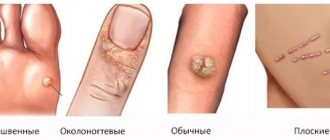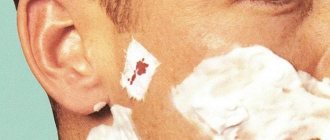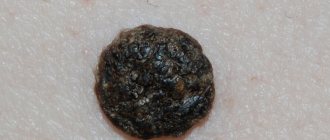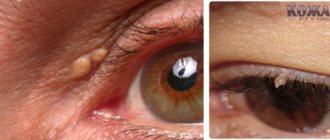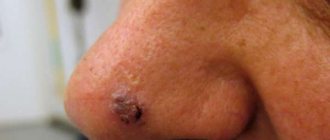“Don’t touch the frog, otherwise warts will appear!” More than one generation has grown up on this erroneous opinion about the nature of the occurrence of untidy growths. Modern medicine has revealed the true reason for their appearance. A wart is an infectious skin disease caused by the human papillomavirus.
We can say that this is a benign tumor. It forms in the epidermis in the form of a growth, tubercle or flat plaque. The Internet contains many photos of warts in children of various shapes and sizes. They can be on the hands, feet, face and other parts of the body. 90% of people around the world, including children, experience this skin disease at least once in their lives.
Causes of warts in children
A child becomes infected with the human papillomavirus (HPV) through the skin or mucous membranes; the following circumstances can lead to this:
- Personal contact with an HPV carrier
- Infection with the virus through household items (toys, office supplies, sharing and carrying other people’s things, sports equipment, public transport handrails, using a shared towel, etc.).
- Visiting public places where transmission of the virus is possible (swimming pools, showers, gyms).
The human papillomavirus, having penetrated the child’s body and encountered a strong immune system, will not appear immediately; the incubation period can be from several weeks to decades.
Several factors contribute to the visible manifestation of HPV warts:
- Weakening of the immune system
- Hormonal changes during adolescence.
- Lack of vitamins.
- Microtraumas, cuts, hangnails, scratches - infection can penetrate through them. These are the main reasons for the appearance of warts on a child’s finger.
- Poor nutrition and non-compliance with the daily routine.
- Incorrectly selected shoes (too narrow, small size, low-quality non-breathable material) leads to the appearance of warts on the feet of children.
- Chronic diseases.
One or more of these factors can lead to the activation of the virus and the appearance of growths.
What is meant by a cyst (growth)?
When it comes to a growth on the gum, most often in such cases we mean a formation or a cyst, which appears for no particular reason. If the growth in the mouth does not hurt, that is, when pressing on it with a finger, it does not cause discomfort, then it is called epulis (also called supragingival in professional terminology).
When this neoplasm is opened, liquid and loose mass will be released. If treatment is not started quickly, then after a certain amount of time the epulis on the gum will open on its own, but first there is a transformation into a small tumor that has an exit (hole) on the surface. From it the fistulous tract goes into the neoplasms. Pus and ichor also come out through the fistula.
A growth on the gum can cause a deterioration in the patient’s general condition; the period of development of the disease is accompanied by loss of energy, frequent headaches, and enlargement of the cervical, ear, and jaw lymph nodes (those that are located near the source of infection).
Reasons for development
Do you have a growth in your mouth on your cheek? Don't panic right away! It is quite possible that the cause of the wart formation was the papilloma virus, which is present in every person’s body. However, this does not mean that such a disease does not need to be treated. If you do not pay enough attention to the growth in time, it will cause a lot of discomfort in the future. So we recommend that you familiarize yourself with the basic methods of treating warts, as well as ways to prevent them.
Features of localization: tongue, throat, lip
Pathological formations can be located in different parts of the oral cavity. They are divided into reactive and neoplastic. The first type is localized in an area of constant irritation (tongue, gums). Neoplastic formations occur rarely. They are located in groups and look like nodular growths.
Warts on the tongue are a common localization of growths. The organ of taste is constantly injured by the teeth, which creates conditions for the penetration of human papillomavirus infection. Condylomas interfere with eating. They often bleed. Visible localization and discomfort force the patient to seek medical advice.
The wart may appear on the inside of the lip. Condyloma does not manifest itself symptomatically. A person does not notice the problem for a long period of time. When the tumor reaches a large size, discomfort in the oral cavity is noted.
A wart may grow in the throat. Patients complain of soreness and coughing. If the element increases in size, normal food intake is disrupted, and the patient’s voice changes. Similar symptoms appear when the tumor is localized in the larynx.
To treat or not to treat a wart in a child?
It is important to observe the warts before deciding on treatment. Most often they disappear on their own within two years or much earlier. But if pain appears, changes in the color of papilloma or their number increases, then you need to consult a doctor.
You can also get help from a specialist if you experience psychological discomfort from the resulting growths. Treatment of warts in children is carried out using traditional or clinical methods.
Complications
In the absence of adequate treatment, the pathology can progress rapidly, which will cause the formation of new lesions. In addition, the risk of developing the following complications increases:
- Hoarse voice.
- Deterioration of speech function.
- Inability to use dentures .
- Impaired respiratory (if papillomas have spread from the gums to the tonsils, larynx).
- Painful discomfort while eating.
- Bleeding .
On this topic
- Oral cavity
Removal of tooth granuloma
- Natalya Gennadievna Butsyk
- December 4, 2020
In addition, the risk of damage to the tumor increases, which causes the development of cancer.
If papilloma appears on the gum, you must immediately contact a dentist, who, after conducting research, will refer the patient to an oncologist or dermatologist.
Traditional methods or treatment with medications at home
The following pharmaceutical preparations are effective: Salicylic alcohol, Salicylic ointment, Oxolinic ointment, Tebrofen ointment, Salipod patch, castor or linseed oil. All these products are applied to the papilloma, which has been previously cleaned and softened with warm water.
You can remove a wart from a child using folk recipes that are safe for health. Juices of herbs such as celandine, spurge or calendula are used. But you need to be careful not to get burned. Daily compresses of onion, garlic or aloe until the growth completely disappears are also effective in treatment.
The use of any remedy at home is possible only after consulting a doctor.
How is a tumor usually removed?
Have you thought about how you can remove a growth in your mouth under your tongue? As a rule, this can be done quickly and painlessly only in a clinic. For this, a wave or laser method is used. Both methods are equally safe, do not leave scars and do not injure the oral mucosa. However, in some clinics, doctors may offer surgical removal of the growth using a scalpel.
As for preventing the development of papilloma, special medications are usually used for this. The main goal of such therapy is to increase immunity, as well as reduce the activity of the virus. For this purpose, drugs that contain acyclovir are usually used. The doctor may recommend tablets, but if we are talking about warts on the lips, then ointments, gels and creams with this component are quite suitable.
It is worth understanding that drug therapy may not be prescribed at all if tests show that the virus is practically absent in the blood. In some cases, the infection does its job (forms warts), after which it is completely killed by the immune system. In such cases, the doctor will only remove the tumor and will also recommend to his patient a set of procedures aimed at increasing immunity.
Clinical treatments
If treatment at home does not bring results, then, on the recommendation of a specialist, removal of warts in children is carried out using surgical methods:
- Freezing with liquid nitrogen is a painless procedure; discomfort is possible after thawing of the papilloma. Used for children who are unable to move during freezing.
- Electrosurgery is the use of electric current to treat common and plantar warts.
- Laser removal is a last resort. The procedure is painful, so it is performed with local anesthesia.
For all clinical procedures, immunotherapy is additionally prescribed.
Diagnostics
If a wart appears on the tongue or in the mouth, it is recommended to consult a dentist, dermatologist or otolaryngologist. At the first examination, a specialist is able to distinguish a wart from another neoplasm. If necessary, diagnostic procedures are prescribed that will determine the type of papillomavirus and determine the degree of oncogenicity. These procedures are:
- PCR analysis, which can detect the quantitative presence of papillomavirus;
- performing a biopsy and histological examination.
Prevention
Prevention is based on reducing the risk of HPV infection.
What causes moles, nevi, warts? Find out here.
Is it possible to burn warts during pregnancy? Read on.
- You should not use someone else's clothing and hygiene items.
- Casual sexual contact is best avoided.
- Strengthening the immune system and a healthy lifestyle, eliminating physical and emotional overload will help prevent the virus from activating.
- To prevent growths on the oral mucosa from appearing, it is important to treat diseases of the gums and teeth in a timely manner and regularly carry out oral hygiene.
The appearance of a wart in the mouth certainly requires careful attention, even if it does not interfere with anything. After all, such a growth can degenerate into a malignant form.
And you should be especially careful when treating a neoplasm in a child’s oral cavity.
For this purpose, it is better to contact an experienced specialist, and use immunostimulating herbal decoctions and infusions from folk remedies.
Symptoms
Photo: neoplasm on the inner surface of the cheek
The main manifestation of HPV is the formation of a growth.
- A neoplasm most often appears on the back of the tongue in the form of a leaf-shaped papilla, which has a rough surface and measures up to 2 cm.
- On the hard palate, inner surface of the cheek and gum, the wart appears as a flat, fine-grained structure.
Mostly, such growths appear in older women due to the constant friction that occurs when wearing removable dentures.

